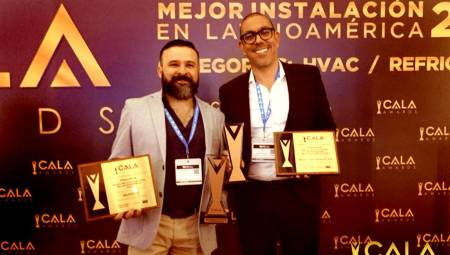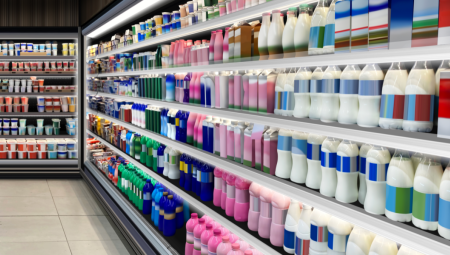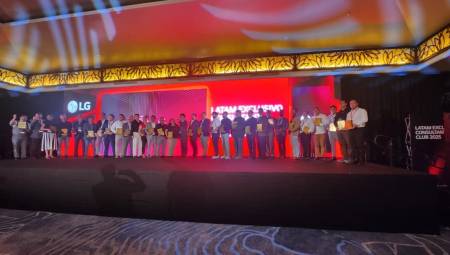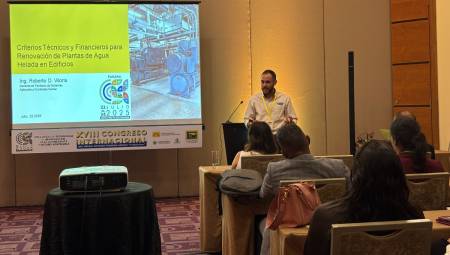On Saturday morning, during the dismantling of the fair, a real fog hovered over the place, caused by the release of the gases used in the cooling of the stands of the same Ministry of the Environment and the UNDP, in commemoration of the 20 years of the Montreal Protocol, and one of the companies chosen as a recycling center.
Just to calculate the damage caused by the release of these gases, it is known that one kilogram of R22 gas released into the atmosphere is equivalent, for the greenhouse effect, to all the CO2 generated by the use of a car for a year. One kilo of 407A for the same effect is equivalent to co2 released into the atmosphere by a car in normal use for two years. That shows the enormous potential of these gases in terms of global warming.
Also at the MMA/UNDP stand , above, were equipment produced by a foreign company promoted by the Brazilian government, which, with that attitude, exports jobs and destroys companies with national technology.
A national team was also presented without the respective security system, mandatory according to CONAMA resolution 340/2003.
Why were the other Brazilian companies that recycle and manufacture refrigeration gas recycling equipment that employ Brazilians not represented?
Most scandalous, however, was the total lack of information; the representative of the ministry, present at the stand, was asked the following questions:
1. Which and how many kilos of gases have been recycled by the program?
2. Why are imported machines displayed at a government stand and how can equipment that does not comply with the legislation be exhibited at an official stand (CONAMA resolution 340/2003)?
3. How do you plan to audit CONAMA resolution 267/2000, given that the entire sector pays a very high inspection tax and this is not carried out?
4. How does the government allow the import of equipment that does not comply with Brazilian legislation, as can be seen in different stands of the fair?
5. Why was the tender for the collection machines awarded to a company that gave the third lowest price, if two other companies had offered lower prices?
6. Why is the certification of equipment required by U.S. standards that do not apply to the reality of our country?
The answer to all those questions was, "I don't know."
We must also take into account the Kyoto Protocol, as far as global warming is concerned and what happens to HCFCs and HFCs.
The lack of figures showing the outcome of the programme is due to the fact that very little gas was recycled and it is not worth bragging that the country is meeting its Montreal Protocol targets just because cfC imports have been reduced.
The reality is that the gases in the deactivated equipment are being released into the atmosphere, causing a real gaseous tsunami against the ozone layer and greatly aggravating global warming.
If the collection and recycling of these gases is not encouraged, the replacement of R22, which they wish to anticipate, will cause another tsunami with serious effects for global warming. From what can be seen, the policy of gas manufacturers, in conjunction with equipment manufacturers, is to sell more and more gases by changing equipment, relegating the preservation of the environment to the background.
In addition, the proposal presented by Brazil, to anticipate the elimination of R22, is conditional on the financing of the lost fund of the replacement of equipment, as happened in the Montreal Protocol.
On the panel of the stand of the largest gas supplier, several companies that made the change are mentioned, as an example for the others. According to an official present, the company is in favor of the collection and recycling of gases, but the destination of the gases removed from the updated equipment was not included in the information panel next to it. The incentive to upgrade, without worrying about the fate of the gases removed from the equipment, demonstrates the little interest in the environment of that supplier and the companies involved.
Another absurdity: to facilitate marketing, the gases are sold in disposable cylinders of 13.6 kg, instead of in returnable cylinders. Inside each disposable cylinder there are, on average, 700 grams of gas that is not used, which considering only 134A, corresponds to about 300 tons discarded along with the cylinders, which end up in the atmosphere. That is equivalent, each year, to more than 500 thousand tons of CO2 for the greenhouse effect.
Only with the massive implementation of recycling and the use of the appropriate equipment can this situation be avoided. In Venezuela, the sale of CFCs and HCFCs in this type of packaging is prohibited, which demonstrates a more responsible environmental stance than ours.
Companies could save a lot of money by recycling the gases from their equipment instead of throwing them out and buying new gas. What this makes clear for society is that the collection and recycling program is managed to not work. The recycling centers that the project supports, or are importers of refrigerant gases, or distributors of one of the largest manufacturers, and therefore, are obliged to meet previously established sales goals. Will that be compatible with the recycling activity?
Another important point: according to the rules of the Montreal Protocol, these centres can only recycle CFCs and are not equipped for R11 recycling. If so, who will recycle the HCFCs and HFCs included in CONAMA resolution 267/2000?
A separate chapter is leak detection. While in Europe the use of the ultraviolet detection system is being considered mandatory to reduce exhaust gas losses, in Brazil, equipment manufacturers claim that the use of this system can harm machines, is it that European machines are more robust? It seems to me that concern for the environment is much more robust.
As a positive record, the magnificent work done by SINDRATAR in the book on the history of refrigeration. The publication is really very nice and well done, it is a pity that it does not contemplate a chapter on gas recycling and its pioneers, but it is understood that it is difficult, in a history book, to write about something that has not yet become a reality.













